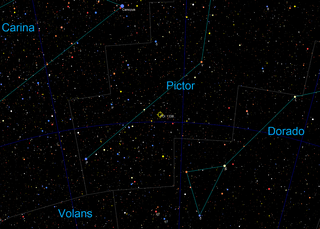TOI-1338の位置 TOI-1338 とは、地球 からがか座 の方向に約1,320光年 離れた場所に位置する連星系 である[ 1] TESS により発見された周連星惑星 のTOI-1338 b が周囲を公転 していることが知られている[ 4]
大きさの比較
太陽
TOI-1338 A
大きさの比較
太陽
TOI-1338 B
「TOI」とは、「T ESS O bjects of I nterestニューヨーク のスカースデイル高校 に通っていた17歳のWolf Cukierによって発見された。彼はゴダード宇宙飛行センター に夏のインターンとして参加し[ 5] プラネットハンターズ 市民科学プロジェクトのボランティアによって食連星 としてフラグが立てられた光度曲線 を調査した[ 6] [ 1] プリンストン大学 に通っている[ 7]
Cukierは惑星に名前を付ける機会を与えられなかった[ 8] SOPHIE 」と命名するよう求める嘆願書には、90,000を超える署名が寄せられた[ 9] ソフィー に敬意を表そうとした[ 10] チャーリー・XCX とキャロライン・ポラチェック が含まれていた[ 9]
TOI-1338は、スペクトル分類 がF8 の恒星 とMの恒星(赤色矮星 )からなる単線分光連星系 である。年齢は約44億年とされている。質量 が1.13太陽質量 と0.313太陽質量の2つの恒星は、14.6日ごとに互いの周囲を公転している。赤色矮星は、主星よりも約9等暗く、スペクトルでは検出できない[ 11] [ 1]
2つの恒星の軌道は89.7°傾いており、明るさの変化は非常に小さいものの、主星と伴星の両方が観測できる。高温の主星が低温の伴星によって部分的に遮られた場合、これは約5時間続き、明るさは約4%低下する。低温の伴星が高温の主星によって遮られる場合、これも約5時間続くが、明るさの低下は0.5%未満である[ 1]
TOI-1338 bの想像図 太陽系外惑星 TOI-1338 b 海王星 と土星 の中間の大きさを持ち、連星と同一平面内で~1°以内の軌道を持っている[ 1] 自転 も、連星と惑星の軌道と一致する(赤道傾斜角 β = ± 17.1ロシター・マクローリン効果 が周連星惑星を持つ恒星に対して測定されたのはこれが2回目である。ケプラー16 は、このような測定を行った最初の惑星系 であった。TOI-1338のアラインメントの測定は、惑星が単一の周連星円盤から形成されたことを示唆している[ 12]
2023年には、ドップラー分光法 により2番目の周連星惑星 TOI-1338 c 公転周期 を持ち、高精度視線速度系外惑星探査装置 (HARPS)とESPRESSO によって発見された。TOI-1338 cはドップラー分光法のみを用いて発見された最初の周連星惑星である[ 13]
TOI-1338の惑星[ 1] [ 13]
名称(恒星に近い順)
質量
軌道長半径 (天文単位 )
公転周期 (日 )
軌道離心率
軌道傾斜角
半径
b ± 20.0M ⊕ +0.0084 +0.031 +0.0043 +0.35 °
± 0.19R ⊕
c 65.2±11.8 M ⊕
0.794±0.016
215.5±3.3
<0.16
—
—
^ a b パーセクは1 ÷ 年周視差(秒)より計算、光年は1÷年周視差(秒)×3.2615638より計算
^ a b c d e f g h i j k l m n o p q r Kostov, Veselin B.; Orosz, Jerome A.; Feinstein, Adina D.; Welsh, William F.; Cukier, Wolf; Haghighipour, Nader; Quarles, Billy; Martin, David V. et al. (2020-05-07). “TOI-1338: TESS' First Transiting Circumbinary Planet” . The Astronomical Journal 159 (6): 253. arXiv :2004.07783 . Bibcode : 2020AJ....159..253K . doi :10.3847/1538-3881/ab8a48 . hdl :10023/20067 ISSN 1538-3881 . https://arxiv.org/abs/2004.07783 .
^ a b Triaud, Amaury H. M. J.; Martin, David V.; Ségransan, Damien; Smalley, Barry; Maxted, Pierre F. L.; Anderson, David R.; Bouchy, François; Collier Cameron, Andrew et al. (2017). “The EBLM Project. IV. Spectroscopic orbits of over 100 eclipsing M dwarfs masquerading as transiting hot Jupiters”. Astronomy and Astrophysics 608 : A129. arXiv :1707.07521 . Bibcode : 2017A&A...608A.129T . doi :10.1051/0004-6361/201730993 .
^ a b c d e f g h i j Vallenari, A. et al. (2022). “Gaia Data Release 3. Summary of the content and survey properties”. Astronomy & Astrophysics arXiv :2208.00211 . doi :10.1051/0004-6361/202243940 Gaia DR3 record for this source at VizieR .
^ “ExoFOP TIC 260128333 ”. exofop.ipac.caltech.edu . 2020年1月9日 閲覧。 ^ Pereira, Ivan (January 9, 2020). “New York teen discovers new planet while interning with NASA” . ABC News. https://abcnews.go.com/US/york-teen-discovers-planet-interning-nasa/story?id=68169897 ^ “Discovery Alert! High School Student Finds a World With Two Suns ”. Exoplanet Exploration: Planets Beyond our Solar System . 2020年2月14日 閲覧。 ^ “Wolf Cukier - Department of Astrophysical Sciences ”. Princeton Edu . © 2022 The Trustees of Princeton University. 6 November 2022 閲覧。 ^ Morrison, Hannah (16 January 2020). “Meet the NASA intern who discovered a new planet on his third day” . BBC News (London, England). https://www.bbc.com/news/newsbeat-51122019 3 October 2021 閲覧。 ^ a b “SOPHIE fans call for NASA to name a planet after the late musician ”. Dazed (3 February 2021). 2021年2月4日 閲覧。
^ Richards, Will (30 January 2021). “DJ and producer SOPHIE has died” . NME . オリジナル の30 January 2021時点におけるアーカイブ。. https://web.archive.org/web/20210130121833/https://www.nme.com/news/music/dj-and-producer-sophie-has-died-2868461 31 January 2021 閲覧。 ^ Martin, David V.; Triaud, Amaury H. M. J.; Udry, Stephane; Marmier, Maxime; Maxted, Pierre F. L.; Cameron, Andrew Collier; Hellier, Coel; Pepe, Francesco et al. (April 2019). “The BEBOP radial-velocity survey for circumbinary planets I. Eight years of CORALIE observations of 47 single-line eclipsing binaries and abundance constraints on the masses of circumbinary planets”. Astronomy & Astrophysics 624 : A68. arXiv :1901.01627 . Bibcode : 2019A&A...624A..68M . doi :10.1051/0004-6361/201833669 . ISSN 0004-6361 . ^ Kunovac Hodzic, Vedad; Triaud, Amaury H. M. J.; Martin, David V.; Fabrycky, Daniel C.; Cegla, Heather M.; Collier Cameron, Andrew; Gill, Samuel; Hellier, Coel et al. (2020-07-01). “The EBLM project - VII. Spin-orbit alignment for the circumbinary planet host EBLM J0608-59 A/TOI-1338 A” . Monthly Notices of the Royal Astronomical Society 497 (2): 1627–1633. arXiv :2007.05514 . Bibcode : 2020MNRAS.497.1627K . doi :10.1093/mnras/staa2071 . https://ui.adsabs.harvard.edu/abs/2020MNRAS.497.1627K/abstract . ^ a b The First Circumbinary Planet Discovered with Radial Velocities , (2023), arXiv :2301.10794
探査機 天体カタログ 主な恒星および惑星
2018年 2019年 2020年 2021年 2022年 2023年 2024年
一覧 関連する その他 公式サイト











